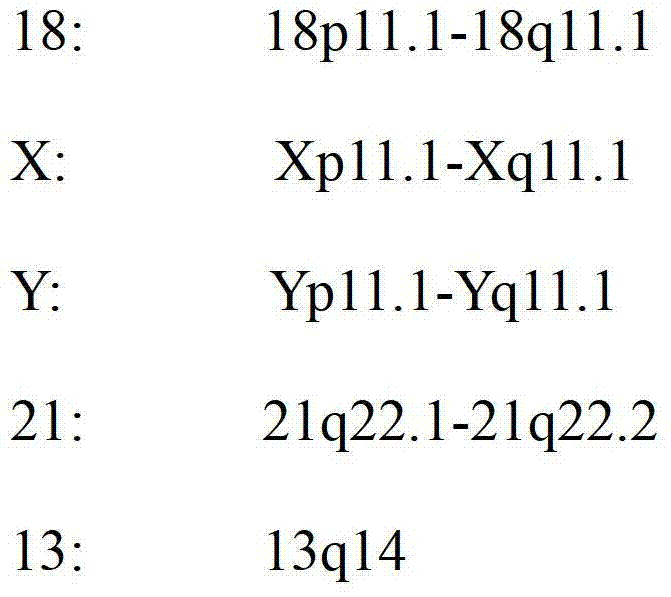An improved co-denaturation fluorescence in situ hybridization method
A fluorescent in situ hybridization and specimen technology, applied in the field of improved co-denaturing fluorescent in situ hybridization, can solve the problems of low experimental efficiency, cumbersome steps, complex operation of classic fluorescent in situ hybridization technology, etc., to reduce the impact on the environment, reduce Experimental procedure, the effect of protecting the health
- Summary
- Abstract
- Description
- Claims
- Application Information
AI Technical Summary
Problems solved by technology
Method used
Image
Examples
Embodiment 1
[0039] An improved co-denaturation fluorescence in situ hybridization method, comprising the following steps:
[0040] Step 1 Preparation of slide specimens:
[0041] The pretreated samples are placed in EP tubes;
[0042] Add 1mL EDTA-trypsin to digest in 37°C water bath for 15min, centrifuge, and discard the supernatant;
[0043] Add 1mL of hypotonic solution to the precipitate, and bathe in water at 37°C for 15min;
[0044] Add 2mL of fixative to pre-fix and mix well, centrifuge and discard the supernatant;
[0045] After adding 2 mL of fixative to fix and mix well, fix at room temperature for 5 min, centrifuge, and discard the supernatant;
[0046] Take the remaining cell suspension, drop the slices, and bake the slices at 65°C for 15 minutes to prepare slide specimens;
[0047] Step 2: Probes covariate and hybridize with chromosomes:
[0048] Add 8 μL of probe solution dropwise to the cell area of the slide specimen, add a cover slip, and drive away the air bubbles...
Embodiment 2
[0060] An improved co-denaturation fluorescence in situ hybridization method, comprising the following steps:
[0061] Step 1 Preparation of slide specimens:
[0062] The pretreated samples are placed in EP tubes;
[0063] Add 2 mL of EDTA-trypsin to digest in a 37°C water bath for 30 min, centrifuge, and discard the supernatant;
[0064] Add 2mL of hypotonic solution to the precipitate, and bathe in water at 37°C for 20min;
[0065] Add 1mL of fixative solution to pre-fix and mix well, centrifuge and discard the supernatant;
[0066] After adding 1mL of fixative to fix and mix well, fix at room temperature for 7min, centrifuge, and discard the supernatant;
[0067] Use the remaining cell suspension, drop the slices, and bake the slices at 60°C for 20 minutes to prepare slide specimens;
[0068] Step 2: Probes covariate and hybridize with chromosomes:
[0069] Add 10 μL of probe solution dropwise to the cell area of the slide specimen, add a cover slip, and drive away t...
Embodiment 3
[0081] An improved co-denaturation fluorescence in situ hybridization method, comprising the following steps:
[0082] Step 1 Preparation of slide specimens:
[0083] The pretreated samples are placed in EP tubes;
[0084] Add 2 mL of EDTA-trypsin to digest in a 37°C water bath for 20 min, centrifuge, and discard the supernatant;
[0085] Add 1.5mL hypotonic solution to the precipitate, and bathe in water at 37°C for 15min;
[0086] Add 2mL of fixative to pre-fix and mix well, centrifuge and discard the supernatant;
[0087] After adding 2 mL of fixative to fix and mix well, fix at room temperature for 5 min, centrifuge, and discard the supernatant;
[0088] Use the remaining cell suspension, drop the slices, and bake the slices at 70°C for 10 minutes to prepare slide specimens;
[0089] Step 2: Probes covariate and hybridize with chromosomes:
[0090] Add 8 μL of probe solution dropwise to the cell area of the slide specimen, add a cover slip, and drive away the air bu...
PUM
 Login to View More
Login to View More Abstract
Description
Claims
Application Information
 Login to View More
Login to View More - R&D
- Intellectual Property
- Life Sciences
- Materials
- Tech Scout
- Unparalleled Data Quality
- Higher Quality Content
- 60% Fewer Hallucinations
Browse by: Latest US Patents, China's latest patents, Technical Efficacy Thesaurus, Application Domain, Technology Topic, Popular Technical Reports.
© 2025 PatSnap. All rights reserved.Legal|Privacy policy|Modern Slavery Act Transparency Statement|Sitemap|About US| Contact US: help@patsnap.com

